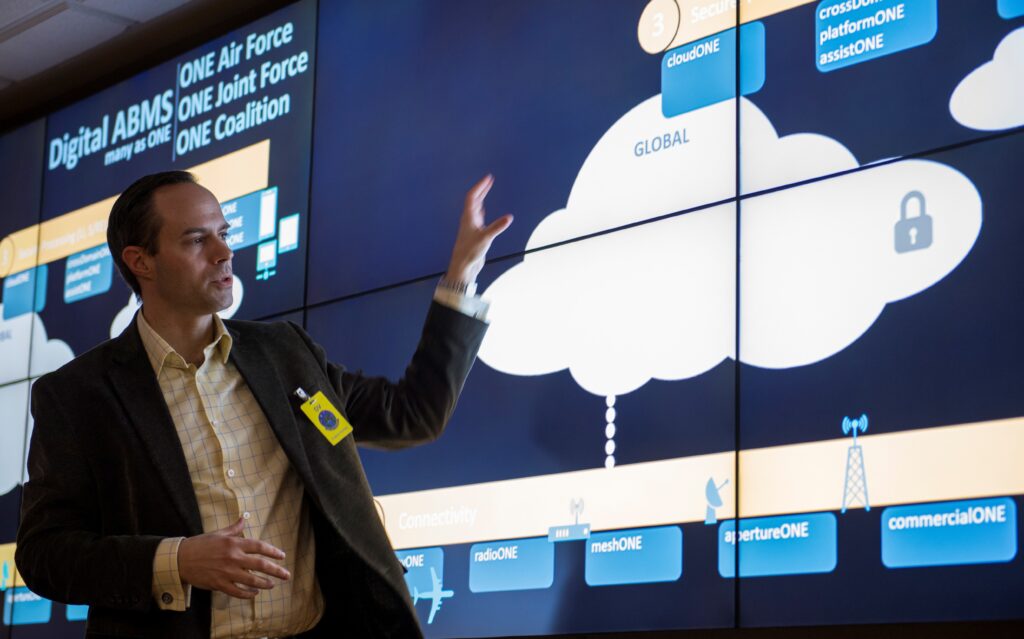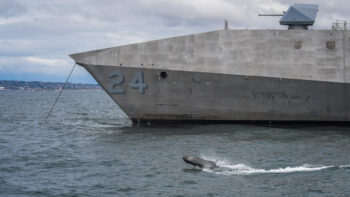
Preston Dunlap, Air Force Chief Architect, briefs Department of Defense senior leaders on the planned core system for JADC2ABMS
Unless DoD puts the C2 back into JADC2, the multi-billion dollar effort meant to transform how America fights may well create the kind of brittle, centralized hierarchy the U.S. military is supposed to avoid.
The U.S. military is pursuing a new concept for managing operations called Joint All-Domain Command and Control. JADC2 seeks interoperability between every sensor, shooter, and command element in U.S and allied forces–essentially a military Internet-of-Things.
The goal of JADC2 is to help commanders to make faster decisions and better integrate actions across domains by accessing any ship, plane, satellite, or troop formation anywhere. In practice, however, JADC2’s current emphasis on communications over command and control could result in more hierarchical organizations, less creativity and initiative, and unrealistic communication demands for the contested electromagnetic environments facing U.S. forces in any conflict against the Chinese or Russian militaries.
Should C2 Be A Dictatorship Or A Democracy?
The inclination of militaries — and governments — toward highly-networked centralized control is understandable. With pervasive visibility into a military force or society and enough computing power, a leader’s planning staff could orchestrate activities to optimize the use of resources and achieve results. This approach could also stifle innovation and eliminate the flexibility to adapt when equipment fails or communications lost.

Bryan Clark
When the Chinese government reported on March 19 that there were no new locally transmitted infections of COVID-19, much of the world looked on in envy. It was a remarkable turn of events from just a few weeks earlier, when 20,000 new cases of the disease were recorded in only 3 days. Some observers wondered whether this success is the ultimate argument for centralized control: after initially trying to protect the party and its image, the national government of China responded quickly and dramatically, locking down the entire province of Hubei to contain COVID-19’s spread.
We aren’t talking about clunky Soviet centralized planning, here, with its bread lines and autarky. China’s approach merges market forces and trade with country-wide information systems and predictive models to assess society and the economy in real time to an extent the Soviet State Planning Commission, or Gosplan, could only dream of.
Soviet planning promised the efficiency of centralized control. With supply perfectly matched to demand, the system could eliminate unemployment, inflation, and even the need for money itself. Obviously, this didn’t quite work out as theorized. Soviet planners lacked communications to closely monitor the economy across six far-flung republics. Even the Soviet invention of linear programming couldn’t provide detailed enough predictions to account for the local variations of the real world.
But what if the underlying assumptions changed? What if China could build a better machine, a “Gosplan with Chinese characteristics” which could take advantage of all the past century’s technological advances? Artificial intelligence algorithms, especially those for deep learning, thrive in the enormous datasets fed by the distributed sensor networks that cover China, from cell phones to street corner cameras to instrumentation of internet traffic.
This explains why China sees the race for artificial intelligence as existential, with Xi himself leading the charge to incorporate AI into academic, industrial, and socio-economic endeavors across China. For Xi’s vision to be realized, his government must deploy a pervasive sensor network to feed data-hungry AI that would make sense of the incomprehensible number and diversity of human activities. If this model works, the argument goes, the Chinese government could achieve unity of effort, its citizens will prosper, and its economy and power will grow. It is a compelling story.

Dann Patt
Yuval Harari concisely paints the contrast between forms of government as information processing systems: “Democracy distributes the power to process information and make decisions among many people and institutions, whereas dictatorship concentrates information and power in one place. “
A similar comparison can be made in military command and control. Given that sensors, computing, and artificial intelligence are becoming ubiquitous, what is the best architecture for their arrangement? Should data be kept within a “castle wall” and flow only to centralized decision-makers? Or should technology be diffused among the ranks, allowing for information-enriched distributed autonomous decision making?
The tragic progression of the COVID-19 pandemic creates a sort of natural experiment to assess these two information models.
After initially downplaying or covering up the crisis to protect its image, China centrally directed an unprecedented lockdown on 23 January, and ultimately drove its new community infection reports down to zero. Although its tests and data reporting may have been unreliable, China’s population was quickly instrumented in multiple ways to support pandemic control, with potentially-infected persons locations reported to government officials.
The centralized model’s vulnerability, however, is that it depends utterly on the perceptiveness, intentions, and foresight of the central decision maker. Even the best AI-enabled decision support tools will guess wrong sometimes, and the likelihood of a bad prediction rises exponentially when an opponent denies or manipulates incoming information. As we have seen in China, centralized decision-making may have resulted in many more deaths due to COVID-19 than has been publicly reported due to poor policy choices and information suppression.
In contrast, the U.S. model decentralizes information generation and use. In the case of COVID-19, we swim in a sea of information and disinformation, with algorithmically mediated social media providing news about the outbreak and disinformation like the case of the purported cocaine cures. Public officials both warn about the severity of the disease and deny its severity, a sort of mixed messaging that would be unthinkable in China.
As a result, early American action against the virus was largely decentralized, with businesses and local governments being the first to act. It reduces unity of effort, but the American model also enables this variety of organizations and actors to improvise innovative approaches including 15-minute point-of-care COVID-19 tests, distributed home tests, genomic monitoring, improvised emergency ventilators, or private industry analysis of social distancing.
Putting The C2 Back in JADC2
The centralized model of decision-making exemplified by China’s management of COVID-19 is also attractive to militaries. A commander could gain enormous advantage by rolling back the fog of war, carefully optimizing plans, and decisively implementing control across the battlespace. This was the aspiration of Net-Centric Warfare during the 1990s.
The U.S. military backed away from Net-Centric Warfare after it became clear the sensing and connectivity required for battlefield omniscience and control wasn’t possible with the funding or technology we had then. The human dimension of warfare also challenged attempts to optimize military operations through networking. As H.R. McMaster noted, even as technology provides improved visibility, “new forms of uncertainty emerge.” War’s fog and friction endures.
Air Force and Army leaders’ public comments on JADC2 could be interpreted as Net-Centric Warfare 2.0, with every sensor, shooter, and commander connected through improved communications links. The highly-networked force would then be able to optimize operations across a theater.
Despite advancements since the 1990s in information processing, AI and mobile communications, JADC2 could still succumb to the same friction, fog, and unpredictability that scuttled Net-Centric Warfare. Throw in world-class Chinese and Russian electronic warfare and JADC2 may end up being a modest improvement in connectivity rather than a game-changing revolution in military operations.
An alternate approach to JADC2 would increase its emphasis on command and control, instead of the current focus on communications. Instead of pouring scarce funding into a potentially-doomed effort to continuously connect every element of the U.S. military, JADC2 should provide a framework for distributing C2 capabilities to a broad set of users. In doing so, JADC2 could balance inevitable communication shortfalls with better local planning and predictive tools. Conversely, greater connectivity–when possible–between commanders, sensors, and shooters could mitigate limitations of C2 tools in modeling and simulation or data engineering.
In this alternative JADC2 model, instead of pursuing optimized theater-wide control, U.S. forces would use the greater interoperability provided by new datalinks, gateways, or on-demand translation to become more adaptable or recomposable, as in DARPA’s concept for Mosaic Warfare. Local commanders could exploit their forces’ adaptability to create dilemmas for the enemy using new C2 and decision-support tools, episodically aligning their efforts when theater-wide communications are available.
Making Mission Command Real
U.S. military leaders argue mission command gives American forces an edge over their adversaries by encouraging subordinate commanders to use their creativity and initiative to improvise new plans and tactics when communications are lost with central headquarters. In a contested electromagnetic environment, U.S. forces using mission command would theoretically be able to adapt and win against a force relying on centralized control.
As U.S. forces become more distributed, introduce more unmanned systems, and work across domains, individual commanders won’t be able to build plans on the fly without access to the planning staffs of central headquarters. JADC2 could overcome this challenge by giving commanders a combination of improved interoperability and decision-support tools, some of which are already in development.
There are clear lessons in the COVID-19 crisis for the architects of our military warfighting and decision-making systems. We should not copy the Chinese approach of feeding all data into a central decision-making apparatus, with its dependence on brittle, artificial intelligence techniques and fallible central decision-makers.
Instead of inadvertently creating hierarchical, centralized control, JADC2 should pursue widely distributed C2. Although, as in the COVID-19 response, centralized control may win a battle, the ability of forces using distributed C2 and mission command to adapt and learn are more likely to win the war.
Bryan Clark, a career submariner who ended his Navy career as head of the Chief of Naval Operations‘ Commander’s Action Group, is a senior fellow at the Hudson Institute.
Dan Patt, former deputy director for DARPA’s Strategic Technologies Office, is a senior fellow at CSBA.






















